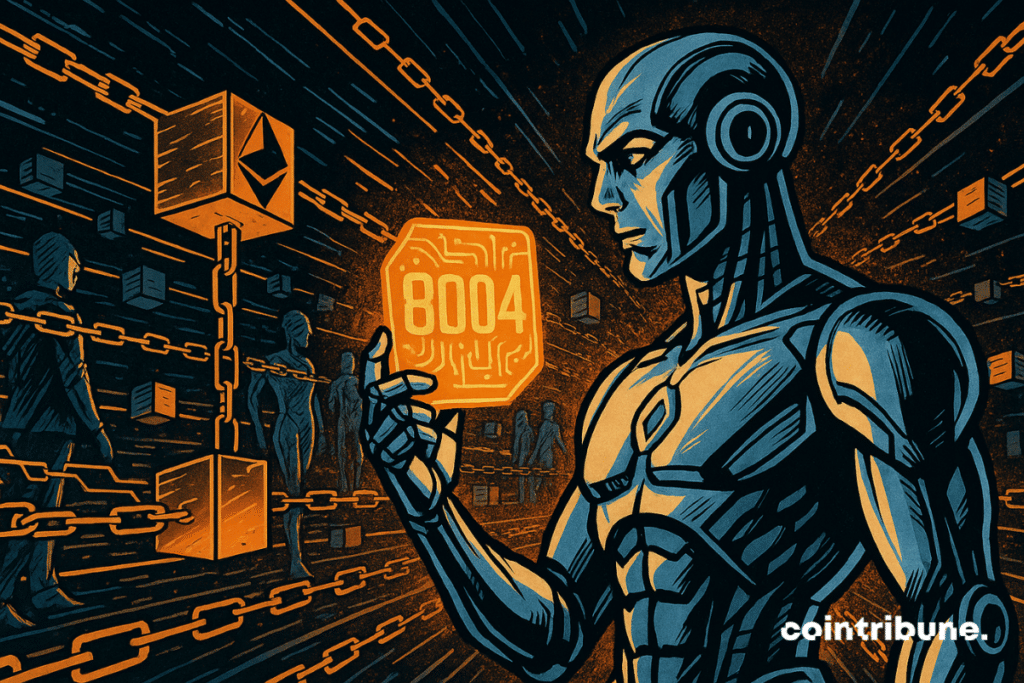Ethereum’s Next Frontier: Millions of Autonomous AI Agents Set to Negotiate Without Intermediaries
Ethereum just flipped the script on traditional commerce—imagine AI agents cutting deals while humans sip coffee.
The Autonomous Revolution
Smart contracts morph into ruthless negotiators, bypassing middlemen who've been skimming value for centuries. No more bloated fees, no more delayed settlements—just pure algorithmic efficiency executing millions of micro-transactions per second.
Wall Street's Worst Nightmare
Banks scrambling to keep up while decentralized networks eat their lunch. Funny how the 'too big to fail' crowd suddenly looks vulnerable to some code and a blockchain. Guess those Ivy League MBAs didn't see this disruption coming—too busy counting bonuses.
The future isn't coming; it's already negotiating.

In brief
- ERC-8004 is based on three registers: identity, reputation, and validation, all recorded on Ethereum.
- The A2A protocol allows AI agents to communicate, cooperate, and trust each other automatically.
- This standard is supported by the Ethereum Foundation, Linux Foundation, Google, Nethermind, and other heavyweights.
- Binji highlights the arrival of a “machine economy” based on an incorruptible foundation.
A new era for Ethereum: the emergence of Trustless Agents
The ethereum Improvement Proposal ERC-8004, nicknamed Trustless Agents, marks a breakthrough for the Web3 ecosystem. Led by Davide Crapis (Ethereum Foundation), this standard introduces an interaction architecture between autonomous agents, often powered by artificial intelligence, without needing prior trust. It relies on three key on-chain ledgers: “Identity”, “Reputation”, and “Validation”.
The ERC-8004 extends the A2A (Agent-to-Agent) protocol, already in use, by adding this distributed trust layer. Each AI agent can thus say “who I am“, “what I have accomplished“, and “here is the proof“. These lightweight ledgers allow interactions between agents without knowing each other or depending on a central authority. It is no longer humans who govern validation, but the decentralized architecture.
Behind this development is a clear goal: to provide a reliable foundation for the autonomous AI economy. As Davide Crapis, initiator of the ERC, stated on Ethereum Magicians:
This standard extends the Agent-to-Agent (A2A) protocol with a trust LAYER that allows participants to discover, choose, and interact with agents beyond organizational boundaries, without requiring prior trust.
And this approach appeals well beyond the Ethereum circles. From Google to Nethermind, several giants have contributed to the proposal. The active support of the Linux Foundation to host the A2A protocol adds weight to this initiative.
Ethereum and the economy of autonomous agents: a step towards intelligent Web3
The ERC-8004 does not merely propose a technical standard: it aims to reorganize the rules of the game around the interaction between artificial intelligences. Thanks to three on-chain ledgers (identity, reputation, validation), Ethereum intends to lay the foundations of an economy of autonomous agents, where machines interact without prior trust, but with verifiability.
ETHUSD chart by TradingViewThis idea is not theoretical. It relies on the A2A protocol already adopted in some tech circles and which ERC-8004 complements with a distributed trust layer. Each agent can now signal what it knows how to do, prove its identity, present its interaction history, and even submit its actions for third-party validation. This is what some observers call the “skeleton of trust”.
This technical foundation, although complex, prepares Ethereum to become the pillar of decentralized AI.
Towards a plug-and-play AI on the blockchain? Key developments to follow
The revolution will not come all at once. But weak signals are already appearing. Coinbase, for example, is testing the HTTP 402 protocol with its x402 system, allowing AI agents to pay without human intervention. The EIP-3009, coupled with stablecoin payments, creates an infrastructure where machines act, decide, and pay. Ethereum, by becoming a playground for these agents, naturally attracts developers, researchers, and entrepreneurs.
Ethereum could thus become the memory of AIs, the backbone of an economy where agents learn, evolve, and interact in a transparent and resilient ecosystem.
What to remember about ERC-8004 and Ethereum AI:
- ERC-8004 was proposed on August 13, 2025 by Davide Crapis of the Ethereum Foundation;
- The standard relies on three ledgers: Identity, Reputation, Validation, all lightweight and on-chain;
- Actors like Google, ConsenSys, Eigen Labs participated in its drafting;
- The A2A protocol is hosted by the Linux Foundation and used by more than 50 partners;
- Tests are underway with Coinbase’s x402, to allow AI to pay in stablecoins without humans.
In the crypto universe, eyes are often turned outward, towards the frictions of the centralized world. With the announced death of LLMs and the emergence of autonomous AI agents, Ethereum seems to offer the right foundation. A ground where artificial intelligence can evolve freely, with incorruptible memory and codified interactions. Trustless Agents are only the first stammerings.
Maximize your Cointribune experience with our "Read to Earn" program! For every article you read, earn points and access exclusive rewards. Sign up now and start earning benefits.

